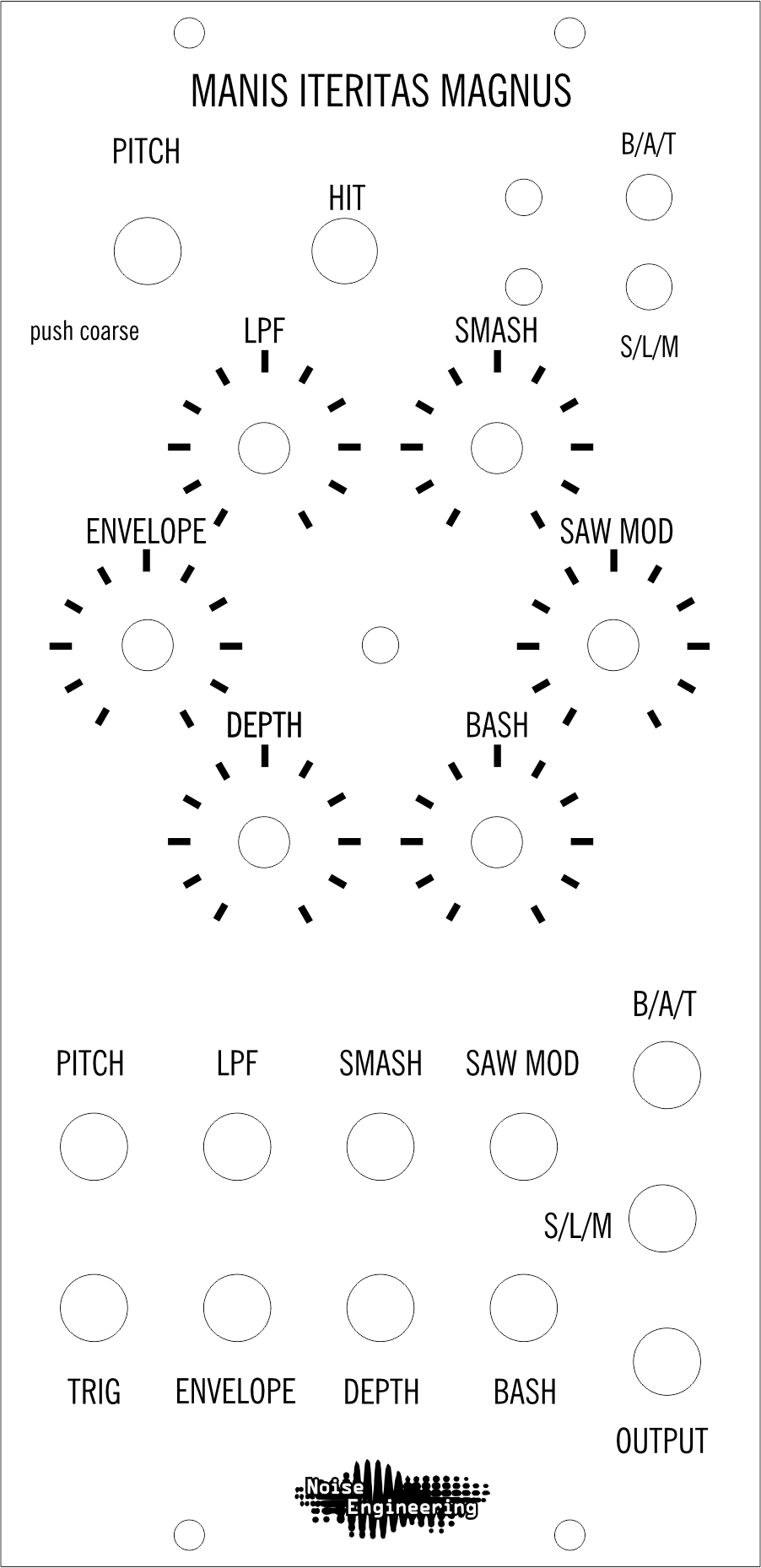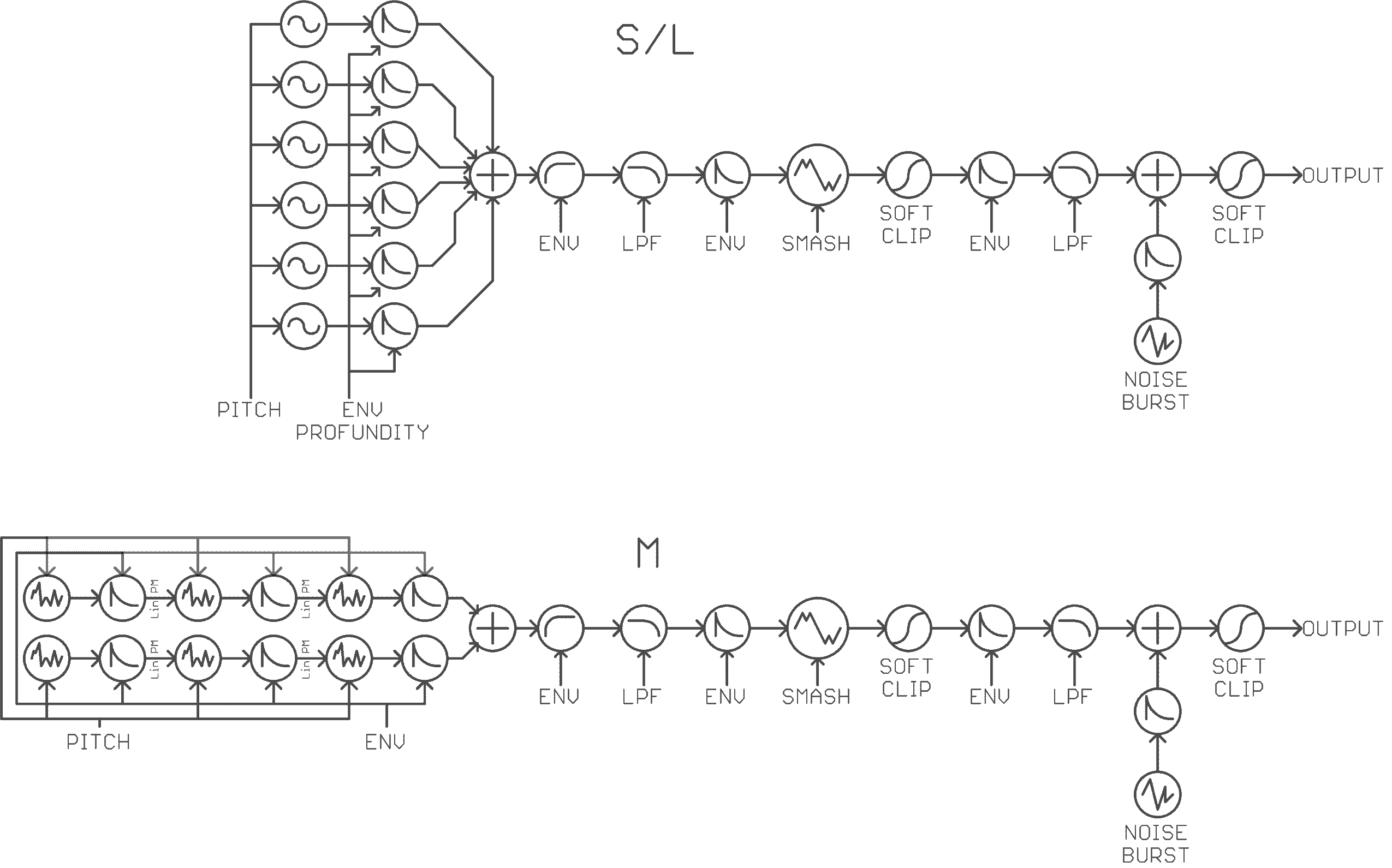Manis Iteritas Magnus Manual#
Gross, gritty, and dark industrial-strength voice
Overview#
"Tastes like paper." - Portrait XO

Manis Iteritas is based on the architecture of Basimilus Iteritas, but designed to be more gritty and aggressive. It accomplishes this by using only sawtooth waves that are manipulated, modulated, and distorted through a rethought interface. Manis is suitable for leads, bass lines, drums, darkness, detuned madness, or pure mayhem.
Manis Iteritas Magnus is the 5U version of Manis Iteritas.
Interface#

- Pitch
- The Pitch encoder knob and CV input adjusts the pitch of the fundamental oscillator. Default is fine mode: steps are sub-perception so it is difficult to bump out of tune. Push and turn for coarse adjustment: each step is a semitone. CV input is a
1 V per octavestandard input. The knob sums with the CV input. - LPF
- The low-pass filter tracks pitch; fully counterclockwise only very low frequencies pass through. Turn fully clockwise to disable. Manis Iteritas Magnus uses two 2-pole non-resonant filters.
- Envelope
- A simple attack decay (AD) envelope control that shapes the amplitude of the signal. Fully counterclockwise, the signal is a short pop. As the knob is turned clockwise, the decay increases. At about two o'clock the attack time will increase slightly as well. When fully clockwise, the envelope no longer affects the amplitude (free-running mode). In this mode, a trigger in or manual trigger will hard-reset the oscillator.
- Saw Mod
- Sounds similar to PWM or sync mod. The operation performed is \(Frac((2 * s + 1) * x)\) where \(s\) is \(knob + jack\) and \(x\) is the current oscillator amplitude.
- Depth
- As the Depth knob is turned clockwise, Manis Iteritas Magnus adds additional, out-of-phase oscillators for a chorus effect and detunes the voice. This is achieved by randomly modulating the sample rate, which results in the perceived pitch becoming blurry.
- Smash
- A gnarly wave-folder replacement, Smash is a modulus-function wave destroyer. The knob sets the level of destruction.
- Bash
- Routes the envelope to Smash, Depth, and LPF. This knob acts as an attenuverter where 12:00 is off, right of center is positive send, left of center is a negative send.
- Mode (S/L/M)
- Selects the mode, see tone generation for more information:
- S (left): Six-oscillator additive
- L (middle): Six-oscillator additive with pitch envelope
- M (right): Two 3-operator phase-modulated oscillators
- Range (B/A/T)
- The range switch sets the lowest note. Each position is two octaves above its left neighbor: Bass, Alto, and Treble.
- Trig
- Triggers the start of the sound. It responds to the rising edge of a trigger and has a threshold of around
3 V. - Hit
- Momentary switch to manually trigger Manis Iteritas Magnus.
- Out
- The out is a low-impedance audio source. The output varies based on parameters as Manis Iteritas Magnus compensates for loudness.
- CV Inputs
- All parameters are CV-able. Knobs act as offsets unless stated otherwise. Manis Iteritas Magnus expects an incoming voltage of
0 V to 5 Vfor non-pitch parameters and0 V to 8 Vfor pitch.
Tone generation#
At first glance is very similar to the Basimilus Iteritas. In Skin and Liquid mode there are six oscillator/envelope pairs that are added together. In Metal mode there are phase modulated oscillator/envelope chains. Metal mode differs in Manis Iteritas Magnus by having two sets of three sequentially modulated oscillators rather that one set of six. Metal mode also waveshapes the output of the oscillators by summing two sawtooths of the same frequency to give a waveform somewhere between a sawtooth and a square.

Variable sample rate#
Manis Iteritas Magnus uses a sample rate that is a multiple of the fundamental (lowest) oscillator frequency. This moves alias power that is a multiple of the fundamental to be mapped to a multiple of this tone, therefore making the aliasing align with the harmonics of the tone. This works well for settings with a strong harmonic structure (spread fully clockwise or fully counterclockwise) and adds unique aliasing character for other tones.
Tuning calibration#
Manis Iteritas Magnus comes pre-calibrated and should not need adjustment. On the off chance the trimpot gets bumped and needs a tuneup, follow this procedure to calibrate your module. Pitch calibration is controlled by an linear resistor-divider network. To calibrate the tuning, attach a voltmeter (preferably 4 or more digit) to the test points TPCV and TPGND on the rear panel and adjust the trim pot.
The voltage measured should be 5/16 (.3125) times the input voltage applied to the CV input. A reasonable way to tune the scale is to use an adjustable voltage source to generate 4 V then adjust the tuning trim until the test points read 1.2500 V. Manis Iteritas Magnus can also be tuned using a reference supply capable of generating a 1 V difference and using a stroboscope such as the Peterson 490 to tune to an octave interval. This is method is preferred to the meter-only method.
Genesis & design notes#
The Eurorack Manis Iteritas came of a suggestion by two friends of Noise Engineering: Matt Lange and Anthony Baldino. Their initial idea was for an alternate firmware for the original Basimilus Iteritas that would be unapologetically aggressive. This sounded like a fun idea and a couple days after our first chat we had enough ideas to give it a try. The first changes were simple. Move to saw tooth only, make the fold into something far more harsh, allow routing of the amplitude envelope to the tone parameters, and sample-rate modulation for a detuned sound. Another early add-on was a second distortion-like thing that would eventually become sawmod. We flashed Matt's Basimilus and gave it a spin.
This version met the goal of being aggressive but lacked a lot of subtlety. Anthony made the suggestion that a filter might be a good addition to help tame the sound. We weren't convinced, but once Stephen worked through the technical details, he was able to implement our first variable sample-rate filter.
We knew we were closer, but we weren't there yet, and so we spent considerable time working on expanding the tone space to have more variety of sounds that were more easily controlled from the knobs. The addition of the AD envelope was great fun, and based on NE user feedback, we tested out the option of removing the envelope from the amplitude. That was one of the last features we developed, but we were pretty happy with the sound (shout out to Patrik Andersson).
The Magnus version is a direct adaptation of the Eurorack hardware. As with the Eurorack version, no pangolins were harmed in the creation of this module.
Manis conservation#
Manis is Latin for ghosts of the dead, which is a pretty good descriptor for the sounds we get out of that beast... but it is also part of the scientific name for a critically endangered scaly mammal from Asia called a pangolin. Pangolins are threatened by wildlife poachers and traffickers. We decided this was an easy connection for us to make in our quest to support science and conservation.
Noise Engineering is proud to be a founding business partner with Save Pangolins, a globally recognized pangolin conservation organization. We've committed to donate a portion of the proceeds from every Manis Iteritas sold to pangolin conservation. That means you can pat yourself on the back for buying a Manis, knowing you're doing some good in the world! Want to know more about what you can do? Check out the Save Pangolins website: savepangolins.org.
Special thanks#
- Matt Lange
- Anthony Baldino
- Patrik Andersson
- Patrick O'Brien
- William Mathewson
- Mickey Bakas
- Tyler Thompson
- Alex Anderson
- Manis logo created by Cynthia Hitchcock